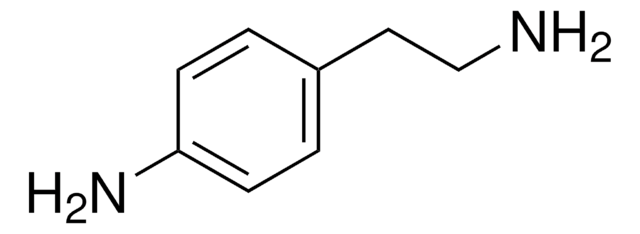D23807
1,3-Diaminopropane dihydrochloride
98%
Sinonimo/i:
1,3-Propanediamine, 1,3-Propanediamine dihydrochloride
About This Item
Prodotti consigliati
Saggio
98%
Forma fisica
powder
Punto di fusione
246-250 °C (lit.)
Stringa SMILE
Cl[H].Cl[H].NCCCN
InChI
1S/C3H10N2.2ClH/c4-2-1-3-5;;/h1-5H2;2*1H
HYOCSVGEQMCOGE-UHFFFAOYSA-N
Cerchi prodotti simili? Visita Guida al confronto tra prodotti
Applicazioni
- Tetradentate bis-phosphine ligands (P(2)N(2) and P(2)S(2)) and their Rh(III), Ni(II) and (105)Rh complexes: X-ray crystal structures of trans-[RhCl(2)(L2)]PF(6), [Ni(L2)](PF(6))(2) and μ-O(2)SO(2)-[Ni(L5)](2)(PF(6))(2).: This study explores the synthesis and characterization of tetradentate bis-phosphine ligands and their complexes, demonstrating significant advancements in ligand design and potential applications in catalysis and medicinal chemistry (Cagnolini et al., 2011).
Avvertenze
Danger
Indicazioni di pericolo
Classi di pericolo
Acute Tox. 3 Dermal - Acute Tox. 3 Inhalation - Acute Tox. 3 Oral - Eye Irrit. 2 - Skin Irrit. 2 - STOT SE 3
Organi bersaglio
Respiratory system
Codice della classe di stoccaggio
6.1C - Combustible acute toxic Cat.3 / toxic compounds or compounds which causing chronic effects
Classe di pericolosità dell'acqua (WGK)
WGK 3
Punto d’infiammabilità (°F)
Not applicable
Punto d’infiammabilità (°C)
Not applicable
Scegli una delle versioni più recenti:
Possiedi già questo prodotto?
I documenti relativi ai prodotti acquistati recentemente sono disponibili nell’Archivio dei documenti.
I clienti hanno visto anche
Il team dei nostri ricercatori vanta grande esperienza in tutte le aree della ricerca quali Life Science, scienza dei materiali, sintesi chimica, cromatografia, discipline analitiche, ecc..
Contatta l'Assistenza Tecnica.













